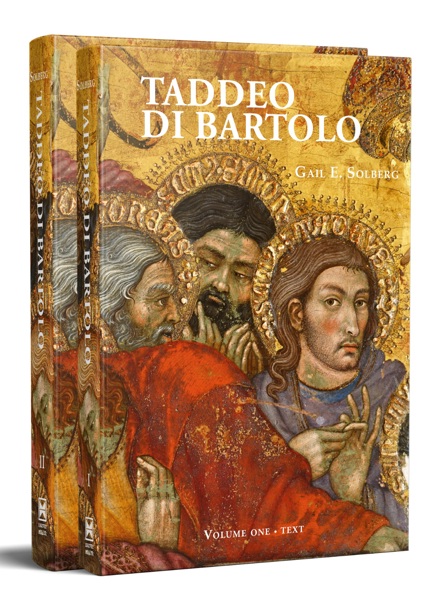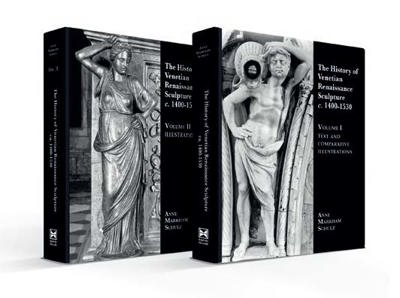
- Pages:2 vols, 1686 p.
- Size:225 x 300 mm
- Illustrations:107 b/w, 674 col.
- Language(s):English, Italian, Latin
- Publication Year:2025
- € 295,00 EXCL. VAT RETAIL PRICE
- ISBN: 978-1-909400-81-8
- Hardback
- Available
A new history of Sienese painting from 1380 to 1420
"The continued dedication of Harvey Miller Publishers (an imprint of Brepols) to the dissemination of cutting-edge, comprehensive and richly illustrated monographs on the history of art is demonstrated by this substantial study of the Sienese painter Taddeo di Bartolo (1362–1422) by Gail E. Solberg. Despite the monumental nature of the book’s achievement, the term that perhaps best captures the aspirations of the author is microhistory. Solberg reconstructs Taddeo’s life and work in Italy in extraordinary detail, reworking and significantly expanding her PhD thesis on the artist, which she submitted in 1991." (Péter Bokody, in The Burlington Magazine, 167, 2025, p. 1252)
Gail Solberg holds history and art history degrees from Stanford and the Institute of Fine Arts at NYU. A resident of Florence, she has written extensively on Taddeo di Bartolo and here gathers decades of research. Her particular interests include the transmission of ideas across the schools of painting, patronage networks, and the mechanics of the painter’s practice. She looks with care at single objects and beyond to the circumstances that endow them with ulterior meaning.
Taddeo di Bartolo, Siena’s premier painter in the years around 1400, is the focus of a cultural history of a great Italian school in an understudied period. His patrons commissioned important fresco cycles and the most impressive polyptychs of the age. In part a travelogue, the text follows Taddeo (ca 1362-1422) from training in straitened times at Siena across central and northern Italy. Ten years of itinerancy drew him to various Tuscan centers, along the Ligurian coast from Genoa to Provence, probably to Padua, and into Umbria. About 1399 he resettled at Siena to rapidly become the preferred painter of his commune. His mural cycles made a greater imprint on Siena’s civic iconography than has been acknowledged while his efficient Sienese shop produced outstanding panel paintings for, among others, the most dynamic religious orders. Until his last years he received grand commissions in and from beyond Siena. He drew a pope’s portrait and was employed by a cardinal at Rome. Attention to his production methods shows how his busy shop ensured variety in numerous paintings for mid-level clients by a flexible design system. Taddeo’s works, including rediscovered and reconstructed paintings, come alive in beautiful illustrations. This chronicle of an indefatigable and successful late medieval career positions the painter, his colleagues, and his patrons in their political, economic, and social circumstances. It provides new insights on Siena’s artistic culture at the start of the Renaissance.
Volume 1
Foreword
Introduction
A Timeline of Taddeo di Bartolo’s Life and Contemporary Events
Part I: Emergence
Chapter 1: Taddeo’s Early Life and Late Trecento Painting in Siena
Chapter 2: The First Altarpieces
Part II: Itinerance
Chapter 3: Florence, Lucca, Pisa, and Padua
Chapter 4: Genoa and Liguria
Chapter 5: Pisa Again
Chapter 6: Genoa and Liguria Again
Part III: Siena: Dipentore Nostro
Chapter 7: The Cathedral
Chapter 8: The Palazzo Pubblico: The Priors’ Chapel and Related Works
Chapter 9: The Palazzo Pubblico: The Antechapel
Chapter 10: The Late Civic Commissions and Taddeo’s Associates
Part IV: Acclamation: Three Grand High Altarpieces
Chapter 11: The Assumption Triptych for the Aragazzi at Montepulciano
Chapter 12: The Double-Sided Heptaptych for the Franciscans at Perugia
Chapter 13: The Heptaptych for the Dominicans at Gubbio
Part V: Variety: Panel Paintings of the First Decade of the Fifteenth Century
Chapter 14: Madonna and Child Paintings, Predellas, and Other Polyptych Elements
Chapter 15: Narrative Altarpieces
Chapter 16: From Monumental Crucifixes to Panels for Personal Devotion
Part VI: Culmination
Chapter 17: Volterra and San Gimignano
Chapter 18: Last Works: Siena, Outside Siena, Orte, and Rome
Chapter 19: Aftermath
Chapter 20: Taddeo’s Legacy
Volume 2
Appendix I: Fortuna Critica
Appendix II: Documents
Appendix III: Problematic Attributions
List of Illustrations
Illustrations
Bibliography
General Index
Index of Works by Taddeo di Bartolo





